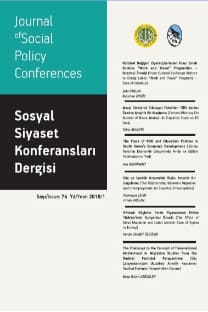TÜRKİYE’DE BİLGİ YÖNETİMİ UYGULAMALARI
Bu çalışmada Türkiye'deki bilgi yönetimi uygulamaları, ampirik verilere dayalı olarak incelenmektedir. Türkiye'de faaliyet gösteren otuz şirketi kapsayan araştırmada şirketlerin bilgi yönetimine bakış açısı ve bu konudaki faaliyetleri analiz edilmektedir. Çalışmada bilgi yönetimi alt yapısı ve süreçleri itibariyle ele alınmaktadır. Buna göre bilgi yönetiminin alt yapısını oluşturan unsurlar teknoloji, kurum kültürü, organizasyon yapısı ve entelektüel sermayedir. Bilgi yönetimi süreçleri ise bilginin üretilmesi ve geliştirilmesi, tasnif edilmesi ve saklanması, paylaşılması ve transfer edilmesi, kullanılması ve hayata geçirilmesidir.
___
- Beijerse, R., “Questions in knowledge management : defining and conceptualizing a phenomenon”, Journal of Knowledge Management, vol. 3, number 2, 1999, pp. 94-110
- Bergman, J. ; Jantunen, A. And Saksa, J.M., “Managing knowledge creation and sharing scenarios and dynamic capabilities in inter-industrial knowledge networks”, Journal of Knowledge Management, vol. 8, number 6, 2004, pp. 63-76
- Beveren, J., “A model of knowledge acquisition that focuses knowledge management”, Journal of Knowledge Management, vol. 6, number 1, 2002, pp. 18-22
- Bhatt, G., “Knowledge management in organizations : examining the interaction between technologies, techniques and people”, Journal of Knowledge Management, vol. 5, number 1, 2001, pp. 68-75
- Binney, D.,“The Knowledge Management Spectrum –understanding the KM landscape”, Journal of Knowledge Management, vol. 5, number 1, 2001, pp. 33-42
- Boisot, M., Knowledge Assets, Oxford University Press : New York, 1998
- Bozbura, T., “Measurement and Application of Intellectual Capital in Turkey”, The Learning Organization, vol. 11, number 4/5, 2004, pp. 44-58
- Davenport, T. and Prusak L., Working Knowledge, Harvard Business School, Boston., 1998
- Dessler, G., Management, Prentice-Hall, USA, 1998
- Fayard, P. M., “Strategic communities for knowledge creation: a Western proposal for the Japanese concept of Ba”, Journal of Knowledge Management, vol. 7, number 5, 2003, pp. 25-31
- Gottschalk, P. And Khandelwal, V., “Determinants of knowledge management technology projects in Australia law firms”, Journal of Knowledge Management, vol. 7, number 4, 2003, pp. 92-105
- Kakabadse N. ; Kakabadse A. and Kouzmin A., “Reviewing the knowledge management literature : towards a taxonomy”, Journal of Knowledge Management, vol. 7, number 4, 2003, pp. 75-91
- Koulopoulos, T. and Frappaolo, C., Smart Things to Know About Knowledge Management, Capstone Publishing Limited, UK, 1999
- Lang, J. C., “Managerial Concerns in Knowledge Management”, Journal of Knowledge Management, vol. 5, number 1, 2001, pp. 43-59
- Lindvall, M. ; Rus I. and Sinha, S., “Software system support for knowledge management”, Journal of Knowledge Management, vol. 7, number 5, 2003, pp. 137-150
- Lopez, S. P. ; Peon, J. M. M. and Ordas, C. J. V., “Managing knowledge : the link between culture and organizational learning”, Journal of Knowledge Management, vol. 8, number 6, pp. 93-104
- Marr, B., “Measuring and benchmarking intellectual capital”, Benchmarking : An International Journal, vol. 11, number 6, 2004, pp. 75-85
- Narasimha, S., “Salience of knowledge in a strategic theory of the firm”, Journal of Intellectual Capital, vol. 2, number 3, 2001, pp. 215-224
- Nemati, H. And Barko, C., “Key factors for achieving organizational data-mining success”, Industrial Management and Data Systems, vol. 103, number 4, 2002, pp. 282-292
- Offsey, S., “Knowledge management : linking people to knowledge for buttom line results”, Journal of Knowledge Management, vol. 1, number 2, 1997, pp. 112-118
- Ordaz, C. and Allez, M. F., “Internal diversification strategies and the process of knowledge creation”, Journal of Knowledge Management, vol. 8, number 1, 2004, pp. 77-93
- Reyes, P. And Raisinghani, M.,“Integrating information technologies and knowledgebased systems : a theoretical approach in action for enhancements in production and inventory control”, Knowledge and Process Management, vol. 9, number 4, 2002, pp. 256-263
- Robertson, S., “A tale of two knowledge sharing systems”, Journal of Knowledge Management, vol. 6, number 3, 2002, pp. 295-308
- Roth, J., “Enabling knowledge creation : learning from an R&D organization”, Journal of Knowledge Management, vol. 7, number 1, 2003, pp. 32-48
- Shani, A. ; Sena J. and Olin T., “Knowledge management and new product development: a study of two companies”, Journal of Knowledge Management, vol. 6, number 3, 2003, pp. 137-149
- Snyman R. and Kruger J. C., “The interdependency between strategic managment and strategic knowledge management”, Journal of Knowledge Management, vol. 8, number 1, 2004, pp. 5-19
- Sveiby, K. E. And Simons R., “Collaborative climate and effectiveness of knowledge work - an empirical study”, Journal of Knowledge Management, vol. 6, number 5, 2002, pp. 420-433
- Thierauf, R., Knowledge Management Systems for Business, Quorum Books, Westport, 1999
- Tiwana, A., The Knowledge Management Toolkit, Prentice Hall, USA, 2000
- Van den Hooff, B. And de Ridder, J. A., “Knowledge sharing in context : the influence of organizational commitment, communication climate and CMC use on knowledge sharing”, Journal of Knowledge Management, vol. 8, number 6, 2004, pp. 117- 130
- Wiig K. M., “What future knowledge management users may expect”, Journal of Knowledge Management, vol. 3, number 2, 1999, pp. 155-165
- Wilhelmij P. And Schmidt R.,“Where does knowledge management add value”, Journal of Intellectual Capital, Vol. 1, No. 4, 2000, pp. 366-380
- Wong, K. Y. And Aspinwall, E., “Characterizing knowledge management in the small business environment”, Journal of Knowledge Management, vol. 8, number 3, 2004, pp. 44-61
- ISSN: 1304-0103
- Yayın Aralığı: Yılda 2 Sayı
- Başlangıç: 1948
- Yayıncı: İstanbul Üniversitesi Yayınevi
Sayıdaki Diğer Makaleler
21. YÜZYILDA TÜRKİYE'NİN SANAYİ VE KOBİ STRATEJİLERİ
TÜRKİYE'DE İHRACAT VE GSMH ARASINDAKİ İLİŞKİNİN KOİNTEGRASYON YÖNTEMİYLE İNCELENMESİ
ORTADOĞUNUN EKONOMİK, SOSYAL VE SİYASİ YAPI ÖZELLİKLERİ ÜZERİNE GENEL TESPİTLER
TÜRKİYE İÇİN REKABETÇİ ÜRETİM VE İSTİHDAM STRATEJİLERİ
REFAH DEVLETİNDE KRİZ VE YENİDEN YAPILANMA
2001 EKONOMİK KRİZİNİN BANKACILIK SEKTÖRÜNDEKİ İSTİHDAMA ETKİSİ
FINANCIAL CRISES IN EMERGING ECONOMIES: A DESCRIPTIVE STATISTICS ANALYSIS
TÜRKİYE’DE KENTSEL YOKSULLUK: KOCAELİ ÖRNEĞİ
